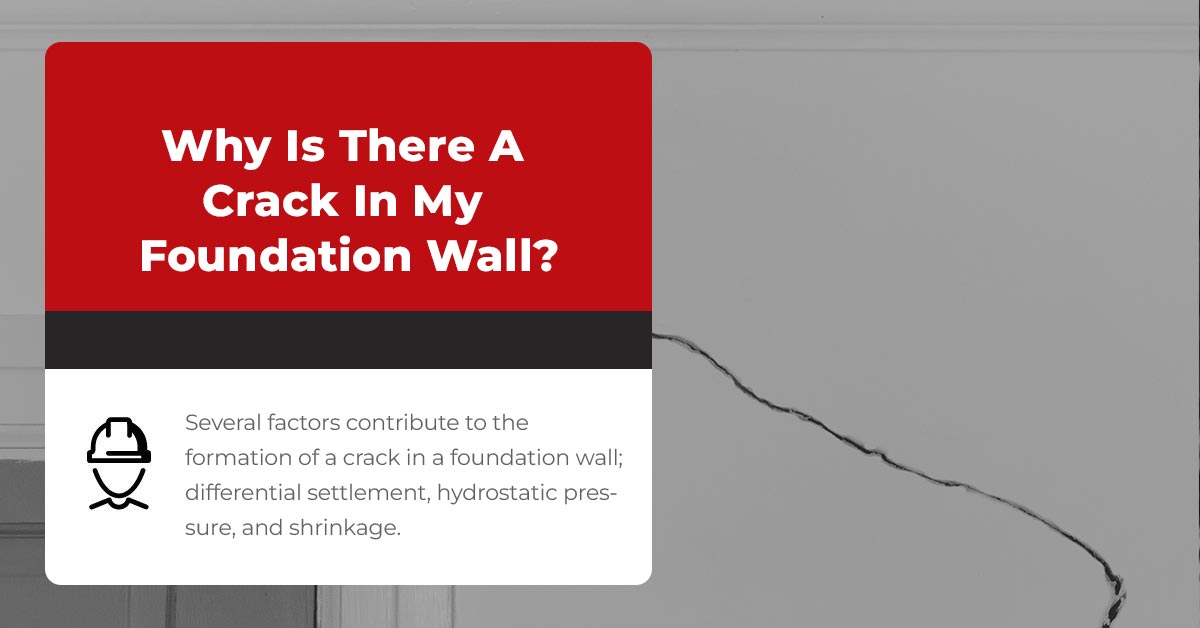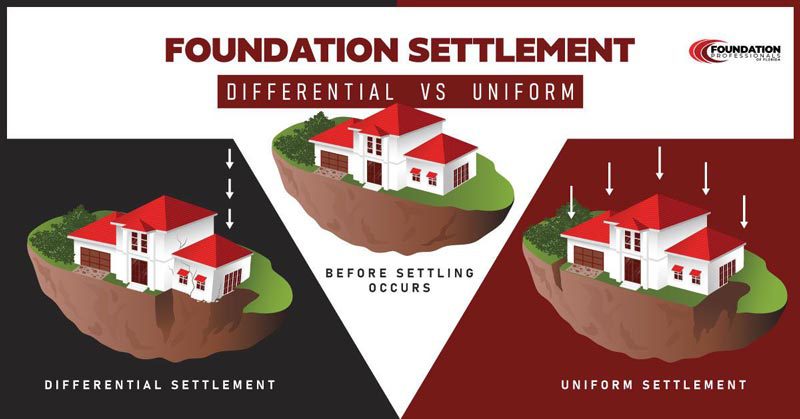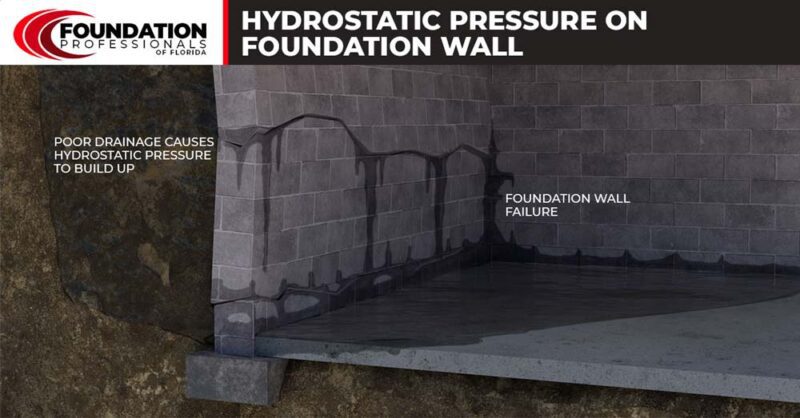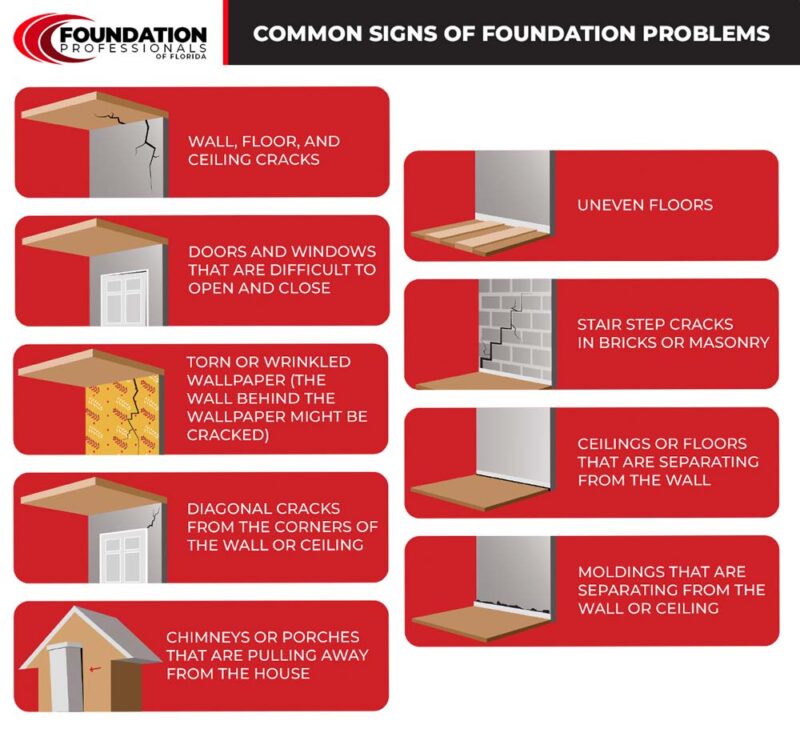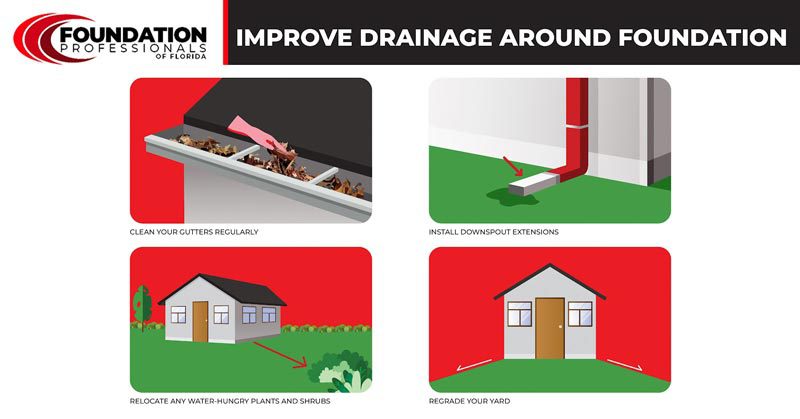Looking for information about a crack in your foundation wall? If so, you’ve landed on the right page because that’s what we’re going to talk about in this article. We’re going to go over the types of cracks in foundation walls, what causes them, repair options for a crack in a foundation wall, and more.
Types Of Cracks In A Foundation Wall
Cracks in a foundation wall are not all the same. Some are horizontal, and others are vertical. You’ll also see diagonal cracks in a foundation wall and stair-step cracks in foundation walls built using bricks or concrete blocks.
Horizontal Cracks
Horizontal cracks in foundation walls often occur when the soil around the foundation is overly saturated with water that can’t drain off. There’s poor drainage around the foundation, in other words. This causes hydrostatic pressure to build up and push against the wall, resulting in a crack that runs parallel to the ground. These cracks can be particularly problematic because they mean the foundation is under significant stress and needs immediate attention.
Vertical Cracks
Vertical cracks in a poured concrete foundation wall, on the other hand, are typically the result of shrinkage during the concrete curing process. While these hairline cracks aren’t structurally significant, they can allow water to enter the basement, and because of this, they should be sealed.
Diagonal And Stair Step Cracks
Diagonal and stair-step cracks (in brick or masonry walls) are usually caused by differential settlement or when the foundation settles into the ground unevenly. See the infographic below for a visual representation of differential settlement.
Regardless of the type of crack present in a foundation wall, a professional must inspect and assess it as soon as possible to ensure that any necessary repairs are made before the issue worsens.
Structural Vs. Non-Structural Cracks In A Foundation Wall
Foundation wall cracks can be divided into two categories – structural and non-structural. Understanding the difference between these two types of foundation cracks is crucial to determine the appropriate repair method.
Structural foundation cracks
Structural foundation cracks are those that negatively impact a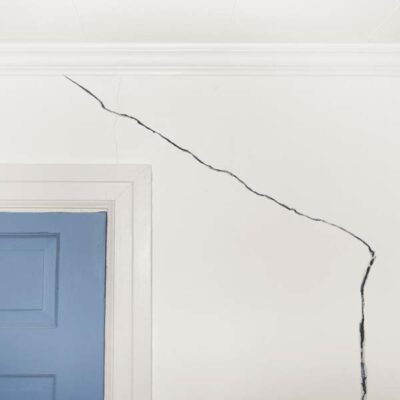
- Typically wider than 1/10 inch
- Horizontal, diagonal, or stair-step cracks
- May be wider at one end
- May be accompanied by bowing
- A series of vertical cracks next to each other
- A crack that goes across the ceiling and down a wall
Structural cracks are serious because they’re an indication the foundation has moved. Leaving structural cracks unrepaired can lead to severe structural damage.
Non-Structural foundation cracks
Non-structural foundation cracks are typically caused by the following:
- Seasonal changes in temperature and humidity
- Minor uniform settlement
- Shrinkage during the concrete curing process (in a poured concrete foundation wall)
Non-structural cracks are generally less than 1/10 inch wide (hairline, in other words) and do not extend through the entire depth of the foundation.
Non-structural cracks are generally not a threat to the structural integrity of the building. However, they can sometimes allow water to seep into the foundation, leading to mold growth and other water-related issues.
It’s important to distinguish between structural and non-structural foundation cracks to determine the appropriate action. Structural cracks require immediate attention and professional repair to prevent further damage to the building, while non-structural cracks can sometimes be addressed with DIY repair methods or left alone.
Regardless of the type of foundation crack, it’s essential to address the issue as soon as possible to prevent further damage from occurring.
What Causes Cracks In A Foundation Wall?
Several factors can contribute to the formation of cracks in foundation walls. These include the following:
Differential settlement
Differential settlement is when a foundation settles unevenly into the soil. This places a lot of stress on the foundation and can cause severe structural damage, including cracks in the foundation wall.
So, what causes differential settlement?
Differential settlement is caused by various things, including the following:
- Soil that wasn’t adequately compacted before construction started – If this isn’t done, the structure could settle into the ground unevenly after it’s built.
- Expansive soil – Soil that contains a lot of clay will swell when it soaks up moisture and then shrink when it releases water and dries out. This creates movement in the ground under the foundation and can, over time, cause differential settlement.
- Erosion-prone soil – Some types of soil are prone to erosion which can cause voids to form under the foundation. If the foundation sinks into the voids, it could result in differential settlement.
- Natural disasters – Earthquakes, floods, sinkholes, hurricanes, etc., can all cause differential settlement.
- Weather changes – Imagine building a house on expansive soil during the dry season. The ground will swell when the rainy season rolls around again, creating movement under the foundation. This can lead to differential settlement.
- Excavation next to the foundation – If your neighbor digs a huge hole too close to your home, it could destabilize the foundation.
Hydrostatic pressure
Poor drainage around the foundation can cause hydrostatic pressure to build up and push against the foundation wall. If the pressure isn’t relieved, the wall will eventually bow inward. It could even crack. A horizontal crack in a basement wall is almost always caused by hydrostatic pressure.
Shrinkage
A hairline vertical crack in a poured concrete foundation wall is common and almost always caused by shrinkage during concrete curing. While these cracks aren’t structural, they can still allow moisture to seep through a foundation wall into a basement or a crawl space. Therefore, they should be sealed.
Many factors can lead to the formation of cracks in foundation walls. Early detection and prompt repairs can prevent more significant problems and save on costly repair bills.
How Are Cracks In A Foundation Wall Repaired?
The chosen repair technique will, of course, depend on what caused the crack in the foundation wall.
Cracks caused by differential settlement
If the crack was caused by differential settlement, the chosen repair solution will probably be underpinning using either push or helical piers.
Underpinning extends the foundation down to soil that can support it. Once the piers are in place, a synchronized hydraulic lifting system raises the foundation to maximum practical level, which is a fancy way of saying the foundation will be raised as much as possible without causing damage.
Cracks caused by hydrostatic pressure
Cracks in a foundation wall caused by hydrostatic pressure might be repaired using C-channel wall anchors, wall plate anchors, or carbon fiber wall straps. These repair solutions will stabilize and strengthen a bowed and cracked foundation wall.
Cracks caused by shrinkage
Cracks caused by shrinkage during the concrete curing process can be repaired using epoxy injections.
Signs Your Home Might Have A Foundation Problem
All homeowners should be able to identify the most common signs of a foundation problem so that proper action can be taken to resolve it. Here are some of the most common signs of a foundation problem:
- Wall, ceiling, or floor cracks – These can appear in various shapes and sizes, ranging from hairline cracks to larger ones that extend from one end of the room to the other.
- Doors and windows may jam or stick – This is often due to the shifting of the foundation, which can cause the frames to become misaligned with the walls.
- Uneven floors – This can occur when one side of the foundation settles more than the other, causing an uneven surface. Uneven flooring can be a trip hazard and a safety concern for the home’s residents.
- Bouncy floors – If you live in a home with a crawl space foundation, bouncy floors can indicate a problem with the wooden support structures in the crawl space.
- Torn wallpaper – The wall behind the wallpaper might be cracked.
- Stair step cracks in brick or masonry
- Chimneys or porches that lean away from the house
- Floors and ceilings that have separated from the wall
In addition to these signs, homeowners should look for water damage or mold growth in the basement or crawl space. This can indicate that water is seeping into the foundation, causing it to deteriorate over time.
Overall, it is important to identify signs of foundation problems early, as they can lead to costly repairs and safety concerns if left unaddressed. Recognizing these signs can help you take early action and prevent further damage to your home.
Tips On How To Help Prevent Foundation Problems
Because most foundation problems are caused by water, the best way to help prevent foundation issues and protect your home’s structural integrity is to control groundwater around the foundation. Here are some ways to do that:
- Install a drain tile system – When it comes to foundation waterproofing, nothing beats a drain tile system. A drain tile system is designed to route groundwater away from your foundation. Installing a drain tile system can significantly reduce the chance of foundation problems caused by water damage.
- Clean your gutters regularly – You don’t want them clogged with decaying leaves and other debris because this could cause water to spill over the side of your house and soak the ground around the foundation.
- Use downspout extensions – They will carry runoff away from your foundation before being released.
- Consider relocating water-hungry flowers and shrubs planted next to the house – These plants can cause excessive moisture buildup in the soil bordering the foundation contributing to foundation problems. Therefore, it’s best to plant these water-loving plants away from your home’s foundation to avoid trouble.
- Regrade your yard – Regrading your yard so it slopes away from your foundation can be an effective solution to avoid water accumulation in the ground around the foundation.
If you’re concerned about a crack in your foundation wall, contact Foundation Professionals of Florida today to schedule a foundation evaluation.

